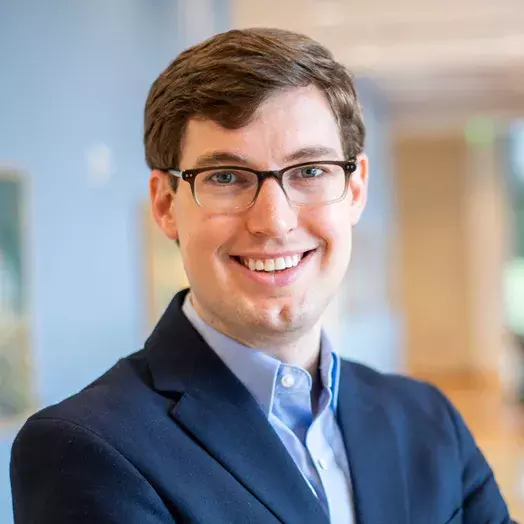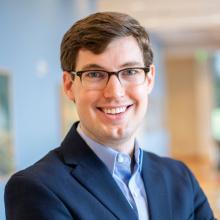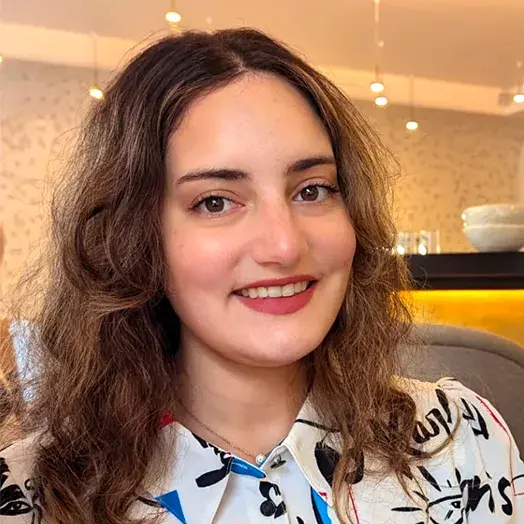
Even Amid Social Distancing, ‘Vicarious Learning’ Can Work
“Vicarious learning” is a term for how we learn from the experiences of others, particularly people in our everyday personal and professional lives.
But can it succeed in a time of masks, quarantining, and working from home? Johns Hopkins Carey Business School Assistant Professor Christopher Myers, who has made a research specialty of vicarious learning, explains in the following Q&A how its principles can prove effective even amid the social-distancing requirements of COVID-19.
The academic director of Executive Education at Carey, with joint faculty appointments in the Johns Hopkins School of Medicine, Myers has written a paper on vicarious learning during the COVID-19 crisis, recently published in Behavioral Science & Policy. He is also among the co-authors, including Bloomberg Distinguished Professor Kathleen Sutcliffe, of a paper on resilient leadership in the face of the pandemic, in BMJ Leader.
Question: Would you give a brief description of vicarious learning? What are some examples of this type of observational learning?
CHRISTOPHER MYERS: Vicarious learning refers to the process of learning from someone else’s experience. This kind of learning is something we do all the time in our personal and professional lives — when we talk about “not reinventing the wheel” or “learning from others’ mistakes,” we are talking about reaping the benefits of vicarious learning. Even as children, we learn a lot vicariously: If we see our parent touch the hot stove and get a burn, we learn from their experience that we shouldn’t touch the stove (without having to experience the pain of a hot stove first-hand). At work, we might learn vicariously from a colleague’s experience on a similar task or project, or try to implement a new strategy based on how a similar strategy was rolled out at another location.
Q: How would vicarious learning be beneficially applied during the coronavirus crisis?
MYERS: Learning vicariously (rather than through our own trial-and-error method) is particularly important when stakes are high and time is short, and when there isn’t a clear, well-established “right answer” for how to respond. As the coronavirus crisis has unfolded, we’ve seen all of these elements – so it can be extremely beneficial to learn from the lessons of others’ experience with the virus. For instance, we’ve seen efforts to learn and apply lessons from other countries that encountered the virus earlier in the pandemic – with leaders around the world trying to replicate early successes and avoid repeating the same mistakes made elsewhere.
Q: In your paper for Behavioral Science & Policy, you mention that digital communications tools and social media can be helpful at this time. How so? And does social distancing hinder learning vicariously to any degree?
MYERS: One of the challenges of vicarious learning is that it requires contact. To learn from someone else’s experience, you need to be exposed to that experience and see how it turned out for the other person. At work and at home, this often takes the form of observational learning (actually watching and witnessing someone else’s experience “live”), but we can also learn vicariously from stories or narratives of others’ experiences. When we ask colleagues for advice at work, for instance, they might tell us a story of a time they faced a similar challenge and how they dealt with it, so that we can learn vicariously from their successes and mistakes, rather than “reinventing the wheel” on our own.
Unfortunately, the same precautions that are helping us curb the spread of the virus (such as physical distancing and stay-at-home orders) make these more typical forms of vicarious learning difficult. If we aren’t in the office, it’s hard to observe a colleague’s experience or stop by their desk to ask advice. This is where critical communication and social media have emerged as extremely useful platforms for connecting people to re-create these kinds of learning interactions. For example, a large number of health care professionals have been using Facebook groups and other digital communication tools to share their experiences and spread best practices (or spread the word on what practices to avoid).
As we’ve all seen and experienced, these digital platforms are not always a perfect substitute for face-to-face interaction, but they can preserve a number of learning benefits that might otherwise be lost amid physical distancing. And in certain cases, these platforms can amplify the benefits of vicarious learning by connecting a broader group than would normally be able to learn from the lessons of someone’s experience. For instance, in one Facebook group for robotic surgeons that I have studied in earlier research, we observed that this group brought together surgeons from all over the globe, allowing people to share their experiences – and get helpful advice and feedback – from a much wider group than they would have if they were just sharing experiences with those in their local hospital.
Q: During the pandemic, do you see vicarious learning as a boon primarily to health care professionals, or does it have applications across a range of professions and disciplines?
MYERS: In my work, I focus a lot on health care professionals’ learning, but I think in these turbulent times vicarious learning is important across all professions. We are in largely uncharted waters in terms of many management practices and business leadership decisions, and every new decision a leader makes is in essence a small experiment in trying to address the obstacles created by the pandemic. It would be an asset in all industries for as many people as possible to learn the lessons of these experiments, so that we would only have to make a bad decision once (and share the knowledge from it so that others can learn), rather than allowing leaders across industries and geographies to keep making the same bad decisions that could be avoided.
“Digital platforms are not always a perfect substitute for face-to-face interaction, but they can preserve a number of learning benefits that might otherwise be lost.”
Christopher Myers, PhD
Q: Your BSP paper proposes policy changes to help advance the principles of vicarious learning during the pandemic. Can you describe how some of those proposals aim to support the observational learning process?
MYERS: Despite these benefits of vicarious learning and the opportunities for harnessing digital communication tools, policy in the health care industry has not quite caught up to these new forms of learning. Many of the requirements and standard practices for health care professionals’ learning (such as continuing education requirements) still emphasize independent, formal modes of learning. Particularly when it comes to digital tools and technologies, the platforms and protections available for health professionals to learn from one another online are still pretty limited.
Having a user-friendly, reliable, and HIPAA-compliant platform for engaging with other health professionals online would be a great asset, as would policy changes to provide these online interactions with similar legal protections that are afforded to in-person discussion and learning among health professionals. We’ve seen fairly rapid policy change in other parts of the health industry in response to the pandemic (such as the rapid adoption of payment models for telehealth), and my hope is we will see similar innovations in opportunities for vicarious learning among health professionals.
About Our Experts

Christopher G. Myers, PhD (Management & Organizations, University of Michigan) is an Assistant Professor and Academic Director of Executive Education at the Johns Hopkins Carey Business School, with joint faculty appointments in the School of Medicine and Armstrong Institute for Patient Safety & Quality. His research explores questions of learning, development, and innovation in organizations, as well as how people learn vicariously from others’ knowledge and experience at work, and he focuses in particular on learning in health care organizations and other knowledge-intensive industries.


